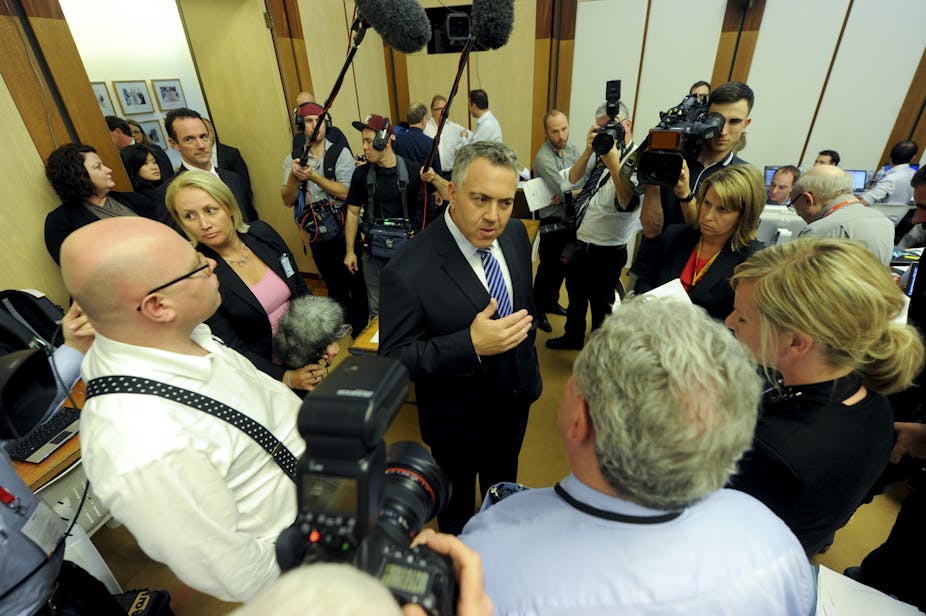In the lead-up to the Abbott government’s first federal budget, there was one standout headline that stole attention from “exclusive” pre-budget leaks:
WHY I’VE GOT A PACKER UP MY CLACKER

In terms of tabloid news, billionaire James Packer’s Sydney street fight with lifelong friend David Gyngell, captured by camera, was gold. But these stories are rare.
Federal budgets, however, are annual events, but remain an important part of the political cycle where words become actions, and are highly anticipated by the editors and journalists chosen to cover them. It is also the press’ opportunity to both attack and praise the budget, depending on the masthead’s audience and the budget’s political messages.
While events such as the Packer-Gyngell brawl and the death of AFL great Tom Hafey did interrupt budget front-page coverage – especially in the tabloids – a snapshot of four News Corp (The Australian, the Herald Sun, the Daily Telegraph and the Courier-Mail) and two Fairfax (The Age and the Sydney Morning Herald) dailies over the past week revealed predictable patterns of political reporting.
These papers were selected because although print revenues are declining, newspapers still set the Australian news agenda for the mass audience. Of a collective 48 front pages, 30 featured budget headlines in the past week, as per the graph below.

While only an indicative sample, there were no surprises that the Murdoch-owned Australian – the only national general news print masthead and appealing to an educated, higher-income audience – had more front-page budget news than other mastheads: eight front-page stories across the eight days analysed.
By contrast, Melbourne’s tabloid Herald Sun had two front budget stories: on budget day itself, and an earlier leak revealing motorists to be slugged with higher fuel costs. It preferred the Packer “biffo” and state politics. This is not surprising given the Victorian election is just months away.
This is consistent with political science research that shows western media tend to overproduce political news compared to other types of stories, focusing on personalities and human-interest angles. Research also finds negative political stories have increased sharply since the 1980s.

News Corp’s Sydney tabloid, the Daily Telegraph, was next in the count with its six front pages headlining budget stories. Its demographic is broader and less affluent than The Australian’s, and its budget stories tended to appeal to hip-pocket interests. Its May 8 headline did not pull any punches with “TONY’S DEBT WISH” about a public backlash over the government’s reversal, since in opposition, not to increase taxes.
News Corp’s Courier-Mail – the same paper that pictured then-prime minister Kevin Rudd during an election campaign debate with the headline “DOES THIS GUY EVER SHUT UP?” – also sent a warning to Tony Abbott on May 7 with “PM’S TAX MUTINY”. Fairfax’s Sydney Morning Herald and The Age and News Corp’s The Australian also reported a voter backlash against the foreshadowed budget’s cuts.
Overall, the stories that attracted the most negative headlines were:
- The higher-income earners’ deficit levy perceived as a “broken promise”;
- Lifting the pension age to 70 years;
- Changing the fuel excise to increase petrol prices;
- Charging to see the doctor, ending free healthcare (outside Medicare levy).
But the negative stories served a purpose for the government. They left little for commentators to gasp over on budget night. The budget night surprises were largely positive stories – $20 billion dedicated to medical research and road infrastructure spending.

All of the sampled front-page coverage began negatively in the week before the budget. But by budget day, stories in News Corp mastheads’ contained more positive messages than rival Fairfax mastheads. Today’s front-page coverage was mixed, but relayed treasurer Joe Hockey’s key messages: The Australian’s headline, for instance, was “JOE LAYS THE PATH TO FISCAL FIX”.
Perhaps two main factors drive newspapers’ budget coverage. One is that, as argued by US academic Michael Schudson, journalists and their outlets resent manipulation by politicians and so, increasingly, political stories are mediatised through their own news judgements and commentaries. This is not to say, however, that other factors such as commercial imperatives do not influence coverage.
The other is that political parties want to control political messages and the “budget story” is no exception. For example, straight from the playbook of spin masters like British prime minister Tony Blair’s media adviser Alastair Campbell two decades before, the Coalition delivered its bad news early. This is a common strategy for first-term governments – to act quickly on unpopular measures – so that a feel-good budget is probable closer to election time.
At the onset of the highly choreographed information releases was the well-timed Commission of Audit report. Perhaps not coincidentally released on May Day (May 1), the report sowed the seeds for the developing narrative of a budget in need of repair.

The report not only delivered headlines like “WHACK!” (The Age) and “WAKE UP AUSTRALIA” (Daily Telegraph) and a grim-faced Joe Hockey pictured above “IT’S THAT CROOK” (Courier-Mail), it provided the Abbott government with key “budget emergency” measures to raise the pension age and tackle the cost of visits to the doctor.
Alongside these tough measures, the Coalition offered a counterbalance, promising “heavy lifting” for all through a temporary levy on higher-income earners and MP pay freezes. With the use of strategic leaks, these measures became the main budget stories in the last week, together with the overriding story of an overblown budget in need of a diet. The Courier-Mail’s headline today is:
THE EXTREME HOCKEY DIET: YOUR PAIN, NATION’S GAIN
Getting the bad news out early did attract negative headlines for the Coalition from press that supported it at the 2013 election. But it also cleared the way for the public to consume more positive “silver lining” stories on budget night. In fact, “SILVER LINING” was the Daily Telegraph’s page one lead yesterday.
With strategic leaks, getting the bad news out early allows more positive headlines to emerge. Thus, the media strategy has done its work.

